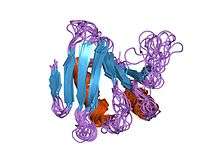Ornithine decarboxylase antizyme
| Ornithine decarboxylase antizyme | |||||||||
|---|---|---|---|---|---|---|---|---|---|
 NMR structure of antizyme isoform 1 from rat | |||||||||
| Identifiers | |||||||||
| Symbol | ODC_AZ | ||||||||
| Pfam | PF02100 | ||||||||
| InterPro | IPR002993 | ||||||||
| PROSITE | PDOC01039 | ||||||||
| |||||||||
In molecular biology, Ornithine decarboxylase antizyme (ODC-AZ) is an ornithine decarboxylase inhibitor. It binds to, and destabilises, ornithine decarboxylase (ODC), a key enzyme in polyamine synthesis. ODC is then rapidly degraded.[1] It was first characterized in 1981.[2] The expression of ODC-AZ requires programmed, ribosomal frameshifting which is modulated according to the cellular concentration of polyamines. High levels of polyamines induce a +1 ribosomal frameshift in the translation of mRNA for the antizyme leading to the expression of a full-length protein. At least two forms of ODC-AZ exist in mammals [3] and the protein has been found in Drosophila (protein Gutfeeling[4]) as well as in Saccharomyces yeast (encoded by the OAZ1 gene).[5]
Human genes encoding Ornithine decarboxylase antizymes are OAZ1, OAZ2, and OAZ3.
References
- ↑ Matsufuji S, Matsufuji T, Miyazaki Y, Murakami Y, Atkins JF, Gesteland RF, Hayashi S (January 1995). "Autoregulatory frameshifting in decoding mammalian ornithine decarboxylase antizyme". Cell. 80 (1): 51–60. PMID 7813017. doi:10.1016/0092-8674(95)90450-6.
- ↑ Heller JS, Canellakis ES (1981). "Cellular control of ornithine decarboxylase activity by its antizyme". J. Cell. Physiol. 107 (2): 209–17. PMID 7251680. doi:10.1002/jcp.1041070206.
- ↑ Ivanov IP, Gesteland RF, Atkins JF (September 1998). "A second mammalian antizyme: conservation of programmed ribosomal frameshifting". Genomics. 52 (2): 119–29. PMID 9782076. doi:10.1006/geno.1998.5434.
- ↑ Salzberg, A.; Golden, K.; Bodmer, R.; Bellen, H. J. (1996-09-01). "Gutfeeling, a Drosophila Gene Encoding an Antizyme-like Protein, Is Required for Late Differentiation of Neurons and Muscles". Genetics. 144 (1): 183–196. ISSN 0016-6731. PMC 1207492
 . PMID 8878684.
. PMID 8878684. - ↑ SGD entry for OAZ1 gene
External links
- ornithine decarboxylase antizyme at the US National Library of Medicine Medical Subject Headings (MeSH)
- OAZ1
- OAZ2
- OAZ3
This article incorporates text from the public domain Pfam and InterPro IPR002993